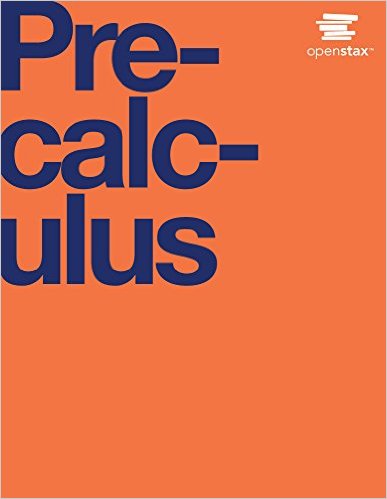
Precalculus

Precalculus is intended for college-level precalculus students. Since precalculus courses vary from one institution to the next, we have attempted to meet the needs of as broad an audience as possible, including all of the content that might be covered in any particular course. The result is a comprehensive book that covers more ground than an instructor could likely cover in a typical one- or two-semester course; but instructors should find, almost without fail, that the topics they wish to include in their syllabus are covered in the text.
License: Creative Commons Attribution. This license is considered to be some to be the most open license since it is the least restrictive. It allows reuse, remixing, and distribution (including commercial), only requiring attribution. The content can be remixed into content of other license, but on the other hand it allows the remix to be put under a more restrictive license.
Formats:
- PDF. A Portable Document Format (PDF) file is can be opened using the free Acrobat Reader. It is not an editable format.
- HTML. An HTML file is a web page document. It can be opened by any web browser. It is an editable format.
Openness Rating (0-4): 3
Openness Comments: The book is only editable in OpenStax/Connexions' editing platform or by editing HTML, which makes it somewhat challenging to remix.
- Preface
- 1. Functions
- Introduction to Functions
- 1.1. Functions and Function Notation
- 1.2. Domain and Range
- 1.3. Rates of Change and Behavior of Graphs
- 1.4. Composition of Functions
- 1.5. Transformation of Functions
- 1.6. Absolute Value Functions
- 1.7. Inverse Functions
- 2. Linear Functions
- Introduction to Linear Functions
- 2.1. Linear Functions
- 2.2. Graphs of Linear Functions
- 2.3. Modeling with Linear Functions
- 2.4. Fitting Linear Models to Data
- 3. Polynomial and Rational Functions
- Introduction to Polynomial and Rational Functions
- 3.1. Complex Numbers
- 3.2. Quadratic Functions
- 3.3. Power Functions and Polynomial Functions
- 3.4. Graphs of Polynomial Functions
- 3.5. Dividing Polynomials
- 3.6. Zeros of Polynomial Functions
- 3.7. Rational Functions
- 3.8. Inverses and Radical Functions
- 3.9. Modeling Using Variation
- 4. Exponential and Logarithmic Functions
- Introduction to Exponential and Logarithmic Functions
- 4.1. Exponential Functions
- 4.2. Graphs of Exponential Functions
- 4.3. Logarithmic Functions
- 4.4. Graphs of Logarithmic Functions
- 4.5. Logarithmic Properties
- 4.6. Exponential and Logarithmic Equations
- 4.7. Exponential and Logarithmic Models
- 4.8. Fitting Exponential Models to Data
- 5. Trigonometric Functions
- Introduction to Trigonometric Functions
- 5.1. Angles
- 5.2. Unit Circle: Sine and Cosine Functions
- 5.3. The Other Trigonometric Functions
- 5.4. Right Triangle Trigonometry
- 6. Periodic Functions
- Introduction to Periodic Functions
- 6.1. Graphs of the Sine and Cosine Functions
- 6.2. Graphs of the Other Trigonometric Functions
- 6.3. Inverse Trigonometric Functions
- 7. Trigonometric Identities and Equations
- Introduction to Trigonometric Identities and Equations
- 7.1. Solving Trigonometric Equations with Identities
- 7.2. Sum and Difference Identities
- 7.3. Double-Angle, Half-Angle, and Reduction Formulas
- 7.4. Sum-to-Product and Product-to-Sum Formulas
- 7.5. Solving Trigonometric Equations
- 7.6. Modeling with Trigonometric Equations
- 8. Further Applications of Trigonometry
- Introduction to Further Applications of Trigonometry
- 8.1. Non-right Triangles: Law of Sines
- 8.2. Non-right Triangles: Law of Cosines
- 8.3. Polar Coordinates
- 8.4. Polar Coordinates: Graphs
- 8.5. Polar Form of Complex Numbers
- 8.6. Parametric Equations
- 8.7. Parametric Equations: Graphs
- 8.8. Vectors
- 9. Systems of Equations and Inequalities
- Introduction to Systems of Equations and Inequalities
- 9.1. Systems of Linear Equations: Two Variables
- 9.2. Systems of Linear Equations: Three Variables
- 9.3. Systems of Nonlinear Equations and Inequalities: Two Variables
- 9.4. Partial Fractions
- 9.5. Matrices and Matrix Operations
- 9.6. Solving Systems with Gaussian Elimination
- 9.7. Solving Systems with Inverses
- 9.8. Solving Systems with Cramer's Rule
- 10. Analytic Geometry
- Introduction to Analytic Geometry
- 10.1. The Ellipse
- 10.2. The Hyperbola
- 10.3. The Parabola
- 10.4. Rotation of Axes
- 10.5. Conic Sections in Polar Coordinates
- 11. Sequences, Probability and Counting Theory
- Introduction to Sequences, Probability and Counting Theory
- 11.1. Sequences and Their Notations
- 11.2. Arithmetic Sequences
- 11.3. Geometric Sequences
- 11.4. Series and Their Notations
- 11.5. Counting Principles
- 11.6. Binomial Theorem
- 11.7. Probability
- 12. Introduction to Calculus
- Introduction to Calculus
- 12.1. Finding Limits: Numerical and Graphical Approaches
- 12.2. Finding Limits: Properties of Limits
- 12.3. Continuity
- 12.4. Derivatives
- 13. Basic Functions and Identities
Supplements:
- MyOpenMath / Lumen OHM online homework. MyOpenMath is a free online homework system, built on the open source IMathAS assessment platform.
It provides randomized, algorithmically generated homework with automated grading of numerical and algebraic answers, similar to WebAssign and MyMathLab.
It also provides a course management system with gradebook, file posting, discussion forums, etc.
Assessment sets have been created for this textbook, which may be available for self-study by students, or can copied as a starter course shell by faculty.
MyOpenMath use is free with community support through forums. For Washington State faculty, the WAMAP.org site also mirrors this content.
Lumen OHM is a commercial alternative to MyOpenMath that provides support for faculty and large scale adoption and administration, service level agreements, and additional curated course bundles. - xyzHomework.com online homework. xyzHomework.com is a commercial online homework site that provides randomized homework custom-built content for OpenStax books and mirrors some of the content from MyOpenMath. They provide support and access to additional content.
- WebAssign online homework. WebAssign is a commercial online homework system. It provides randomized homework custom-built to align with textbooks. Question sets have been created for this textbook which can be built into assessment sets by faculty. They provide support.